Ladakh. Historical overview.
India. February 2009
Ladakh – a small province in northern India, part of Jammu and Kashmir. The capital of Ladakh – town Leh. The capital of Jammu and Kashmir is city of Shrinagar.
A distinctive feature of Ladakh – high altitude location and complete isolation from the outside world. The average height of the province – 3000 – 7500 m above sea level. Ladakh is bounded from the north by Ladakhy mountains, and in the southern part Ladakh simply get into the main Himalayan ridge . The closest neighbors – China, Afghanistan and Pakistan. Ladakh population live mainly at altitudes of 3000 – 4500.
The main Himalayan ridge, like a shield closes Ladakh from the South. The result – the number of rains in this area, equal to only a few centimeters per year. Ladakh landscape resembles to the moon – brown, inhospitable, rugged mountains. In the valleys people in the short and not very hot summer with great difficulty cultivat agricultural products. During the summer, it is necessary not only to procure vegetables, and gather up firewood, dry dung (primary fuel for the local population). The cattle fatten weak fat. Official Indian medicine in the territory of Ladakh is presented only as a possible Emergency helicopter assistance for several days in case of serious illness. Area do not receive government dotations (according to locals), people do not have social payment. The only one government person whom are able to recall the locals – the king, periodically lives in the village Zangl in his royal palace. The work actually exists only in the tourism business. Retirement age – 40 years …. Very often, Ladakh is called a diamond in Central Asia or Small Tibet. In his time through Ladakh passed the Great Silk Road.
Location near Tibet made a dominant influence on the culture and religion of Ladakh. After Tibet became part of China, it turned out to be the main Buddish country after Tibet.of the Ladakh Buddhist. Today, the role played by ladakhy monasteries (gompa) is difficult to overestimate.
Monasteries (gompa) of Ladakh usually located in the most important strategic points. Almost always the monasteries are located near the villages on the cliffs or on the dais. Monastery walls are high. They are thick and wide, the windows are usually high up under the roof. Monasteries successfully coped with the defense function.
Everywhere in the valley, near the monasteries on the slopes of the mountains and near the villages scattered Chortens (small stupas). According to various sources Chorten or represent themself model of the world or contain dust of lamas or religious shrines. In any case, the Chorten protect people from evil spirits. The most famous mantra Om Mani Padme Hum is engraved on many rocks and decomposed at the base of Chortens.
History of Ladakh. Very briefly.
For a start it would not hurt to say that the information that exists today in different sources is quite different! Therefore, the history of Ladakh, which I bring to you, also can be very different from any other source. It is also quite different names of the conquerors and rulers of Ladakh. The names of settlements may also be different in different sources.
In the 9 century, the great grandson of the King of Tibet arrived in Ladakh with 100 soldiers, and married a daughter of the local ruler. Later, his son became the rules of Ladakh.
In the 11 th century king of Ladakh Utpala expanded his kingdom to the borders of the Kingdom of Mustang and founded several Buddhist monasteries.
15 and 16 century Ladakh held under the patronage of Muslim rulers of Baltistan. 100 years later the ruler of Ladakh has signed an agreement with the Kashmiri ruler for help in the war against the Baltistan. Since that time, Ladakh nominally became subordinate Kashmir, preserving cultural and religious ties with Tibet.
In 1834 the province was conquered by the army under the leadership of Zorava Sikgh, after that Ladakh finally came under the direct control of Kashmir. After 1962 the road connected with Shringar Leh and started a real cultural and economic expansion of the province.
In 1974, the region is open for tourism.
Buddhism in Ladakh. MONASTERIES of Leh.
Buddhism in India does have not a very noticeable trail. India, one of the few countries, that tolerate to any religion. In the jungles of Indias civilization, without any fanaticism, quietly burn all religious beliefs and there remains only the eternal host of Hindu gods. Ladakh, however, in this case is the center of Vajrayana Buddhism. This form of Buddhism was introduced in 5-6 A.C. under the influence of Tantrism. By itself, Tantrism is a complex ritual movements, taken from the Hindu, whose ultimate goal is to unite the masculine and feminine. There could be a special practice and sex as a means of achieving nirvana (a very simplified explanation).
Vajrayana Buddhism was brought from Tibet to India by Guru Rimpoche. He founded the group of Red Hats, which followed tantric doctrine, perfectly combining it with a kind of Tibetan shamanism – the Bon religion.
Lamaist variety of Buddhism claims to be a more complete explanation of the messages of the Buddha. The monks of this trend are the yellow hats, called the Gelug-pa, and do not use the magical practices and Tantrism in its teachings.
Cloisters Spituk and Tiksi – the most important religious centers in Ladakh.
Gonpas of Ladakh were mostly built in the 10 – 17 centuries at the intersections of caravan routes and the Silk Road. Monasteries have always occupied a strategic location on higher ground. Built in several floors and painted white with absolute purity and often had blue color of luck around windows and doors. Dark red paint was supposed to drive away evil spirits from the monastery. All the monasteries have the same structure – a large courtyard, the main hall (the most ancient and important part of the monastery), a Buddhist temple, monks rooms, library and living room, the abbot of the monastery, the chiefs lama room. Sometimes in the monastery are the royal apartments.
The monasteries are built of brick, stone and wood. The walls are decorated with drawings of the monasteries, but because of the frequent renovations dating is not possible.
Around Monasteries are Chortens, which should bypass ONLY clockwise.
City of Leh is situated at an altitude 3505m in enormously wide valley. Its small houses are crawling somewhere on the slope. The huge, ruined 16 th century palace dominates on the city.
Only 15 km from the town there is another palace built by King Shay. The palace is famous for the largest stupa with gold-plated spire, huge sitting on two floors of the Buddha. From the top of Shay palace can be seen the next hill with the monastery Tiksi. From this monastery opens a great view to the valley and the river Indus. The monastery still has very important statues of Buddha. There is a large library, a school of painting.
The greatest in size and importance is the monastery of Hemis. It was built in 17 century and still is under the patronage of the royal family (as it is written everywhere, but nowhere indicated which royal family). Hemis Monastery – a sort of headquarter of Red Hats and all the other monasteries of this trend in Ladakh obey him. The monastery has a shelter for pilgrims. On the wall hangs a large poster with a request to be notified about the visit beforehand. Rooms for teaching and meditation are decorated with wall paintings, large racks are stored most important book. In the center is a statue of Buddha. On the contrary stands a big drum, with a monk reading mantras and special taps on the drum beater. The larger diameter of the drum, the lower it sounds. Each drum, even the same diameter, has different sounds. Periodically, the monks voice grows stronger. He picks up two small copper plates – Karatal – and hit them against each other. Karatal – Nepal – Tibetan musical instrument. Originally they were made of seven metals, as well as singing bowls. The structure Karatal necessarily entered a meteorite, “heavenly” metal, which gave them a slightly pearly colour. Unfortunately, the meteorite is a rare, so not all Karatal it contains.
Karatal come in different sizes and each has his own sound. Most of them are smooth, but there are also decorated with engraving, chasing dragons, eight images of good characters.
The floors in the halls made of stone. They are cold. Enter inside in shoes is strictly forbidden.
Another important for life Ladakh monastery lies 10 km on the road to the city of Kargil. This monastery Spitoc. This is a fairly large Gonpa, with numerous buildings, several large rooms and a magnificent view of the river Indus. In the monastery saved statue of the goddess Kali, whose face can be seen only once a year. We were lucky – we were on holiday of monastery. Since from all the surrounding towns and villages in the monastery passed people. Near the monastery has opened a real fair. Ladakhy sell momo (dumplings), tea from thermoses, nuts and all manner of small items such as socks and gloves. Another sell oil, Sunflower. For religious offerings.
People went to the monastery festively dressed, families with children. Basically ladakhy dressed either in local production of clothing – a long homespun coat drier color from sheeps or yak wool, white rubber boots, lace-up (!) Or in the remains of a civilized tourist clothes. Grandmather in sleeveless company The North Face and worn crosses – absolutely normal. White rubber boots are in fact the official footwear of the local army. Its hard to say, this miracle is specially designed for Ladakh or all the Indian army is equipped with such shoes.
Ladahsky women braid their two long braids that dangle on the back. The ends of the braid are usually tightened with an elastic band. All ladakhy women, like women all around the world, like decorate themself. In the ears women wear long earrings with river pearls. On their necks – a necklaces of turquoise and coral. There are a lot of ordinary, rather crudely made from silver rings with turquoise. Rings wear not only women but also men.
At monasteries crouds people. From the roofs hung their curious heads. Several foreigners were running in the center of the courtyard. But performance suddenly appeared in the same calm and measured, as all life of ladakhy. Once every 10-15 minutes came out 3-4 actors in masks and robes and we hear the sounds of Tibetan pipes, drums and Karatal . All this – shaman dancing, one of the main tasks of which ward off evil spirits. Tibet pipes can reach a length of 6 meters. The sounds they emit extremely low and deep. Of course, such a tube is difficult to hold in their hands and it is usually put on a special stand.







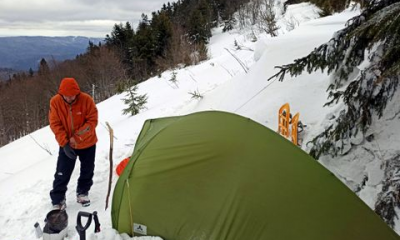
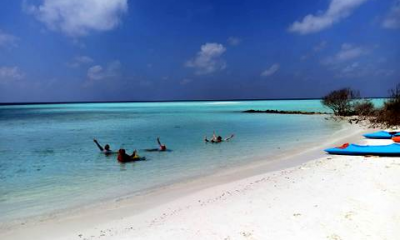
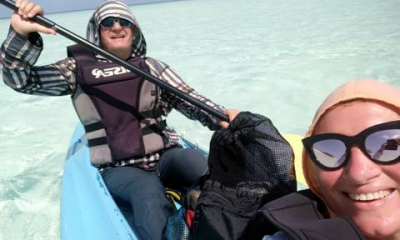



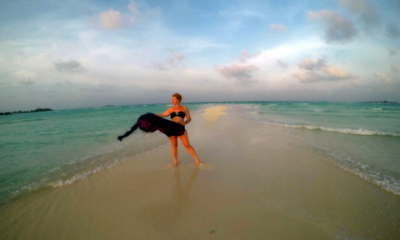
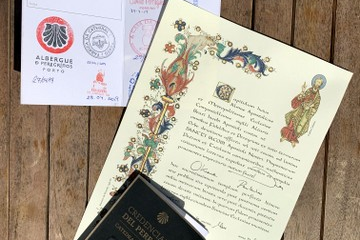
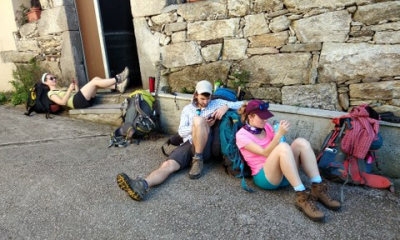
 English
English  Russian
Russian 